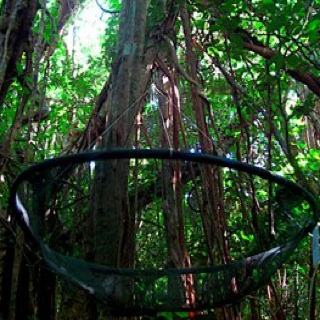My inner geek comes out when I read articles like this. I did a summer internship while I was still in highschool at the University of Guam doing research but nothing as interesting as this.
Here’s the article:
The forest on Guam is silent.
Sometime after World War II the brown tree snake arrived as a stowaway on this U.S. Pacific island territory 6,100 kilometers west of Hawaii. It has since extirpated 10 of the island’s 12 native forest bird species. The remaining forest birds have been relegated to small populations on military bases, where the snakes are kept in check. In the first study of its kind, a rugby-playing researcher named Haldre Rogers is documenting how the forest itself is changing.
“There’s nothing in the forest on Guam,” Rogers says, “and when you hear anything you have to stop and say, ‘What was that?'”
Rogers is a doctoral student at the University of Washington in Seattle who once had a cell phone with the number 777-HISS during the three years she worked for the U.S. Geological Survey’s brown tree snake rapid response team. From 2002 to 2005, she estimates she nabbed about 100 snakes out of a population estimated in the hundreds of thousands.
These days, between tournaments in Hong Kong and Thailand with the Guam national rugby team, she has been busy collecting data on the movements of seeds and their ability to survive and grow in the forest. “People knew that the birds had disappeared, but nobody had taken the next step to see what impact that had,” she explains, “which is why it seemed like enticing research.”
Of the approximately 40 species of trees on Guam, about 60 to 70 percent once depended on birds to eat their fruits and disperse their seeds. The birds may have just nicked and dropped seeds somewhere along a flight path, or they could have swallowed the seeds, digested their tough coats, and pooped them out with a splatter of high-nitrogen urea.
Rogers went to neighboring islands that still have birds along with many of the same trees, collected seeds from the tree Premna obtusifolia, and brought them back to grow in a greenhouse on Guam. She found that seeds handled by birds are twice as likely to germinate as seeds that simply land on the forest floor. They also germinate about 10 days more quickly, giving them a better shot at evading seed-destroying rodents or fungi.
In another experiment, Rogers has found that seeds on Guam now always land directly in the shade of the mother tree and always have an intact seed coat. But seeds from neighboring islands that still have birds can sometimes end up 10 to 20 meters away from the mother tree, where they are more likely to find a sunny niche with fewer enemies. About 80 percent of these have had their seed coat removed, meaning they can germinate more quickly. Rogers presented this research at the Ecological Society of America meeting in Albuquerque this week. “It’s inevitable that there will be changes in the composition of the forest and in the spatial patterns of where trees are located,” she says.
These results, which are just the beginning of a larger study funded by the National Science Foundation and the U.S. Department of Agriculture, have wider implications for the dispersal of seeds and botanical life. Some 25 percent of U.S. birds are facing extinction, and many common U.S. bird species have declined by 50 to 80 percent since 1967. On islands, the situation is particularly dire, with 28 to 56 percent of species expected to be extinct by 2100, many due to introduced species. Hawaiians are dreading the day when the brown tree snake inevitably establishes itself there, despite careful monitoring of airports and shipping facilities.
Rogers is now looking for similar trends in a dozen other tree species on Pacific islands, and investigating how the absence of birds has affected populations of agricultural pests and spiders, which are 40 times more abundant on Guam than on neighboring islands. She says it is still too early to know if the brown tree snakes are just altering the distribution of trees in the forest, or if they could lead to a collapse of the island’s entire ecosystem.
“The brown tree snake is held up as textbook example of how a destructive invasive species can eradicate birds,” she says. “This shows that the effects of introduced predators reverberate through the ecosystem.”
By Brendan Borrell
References:
http://www.scientificamerican.com/article.cfm?id=avian-silence-without-bir



